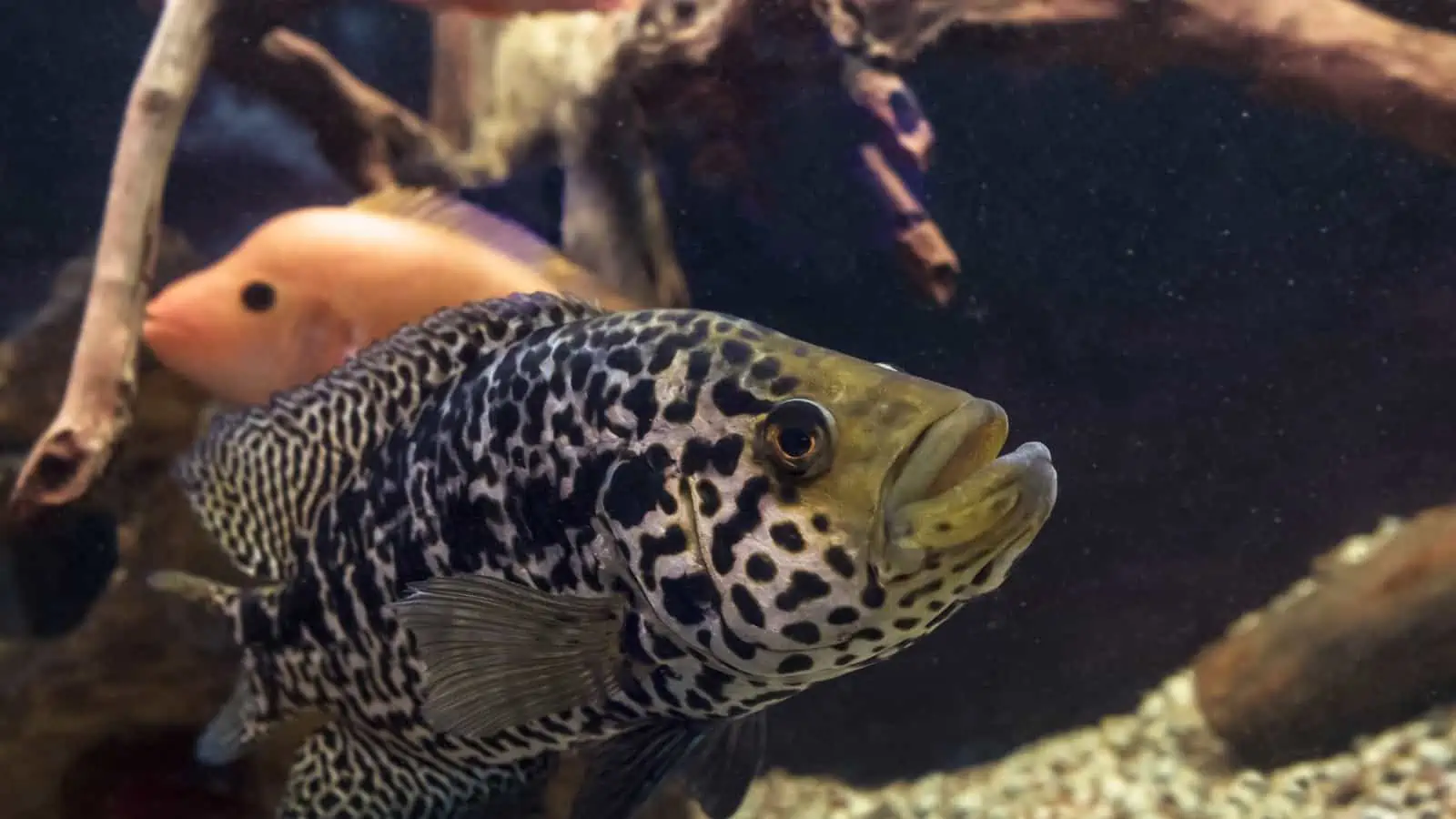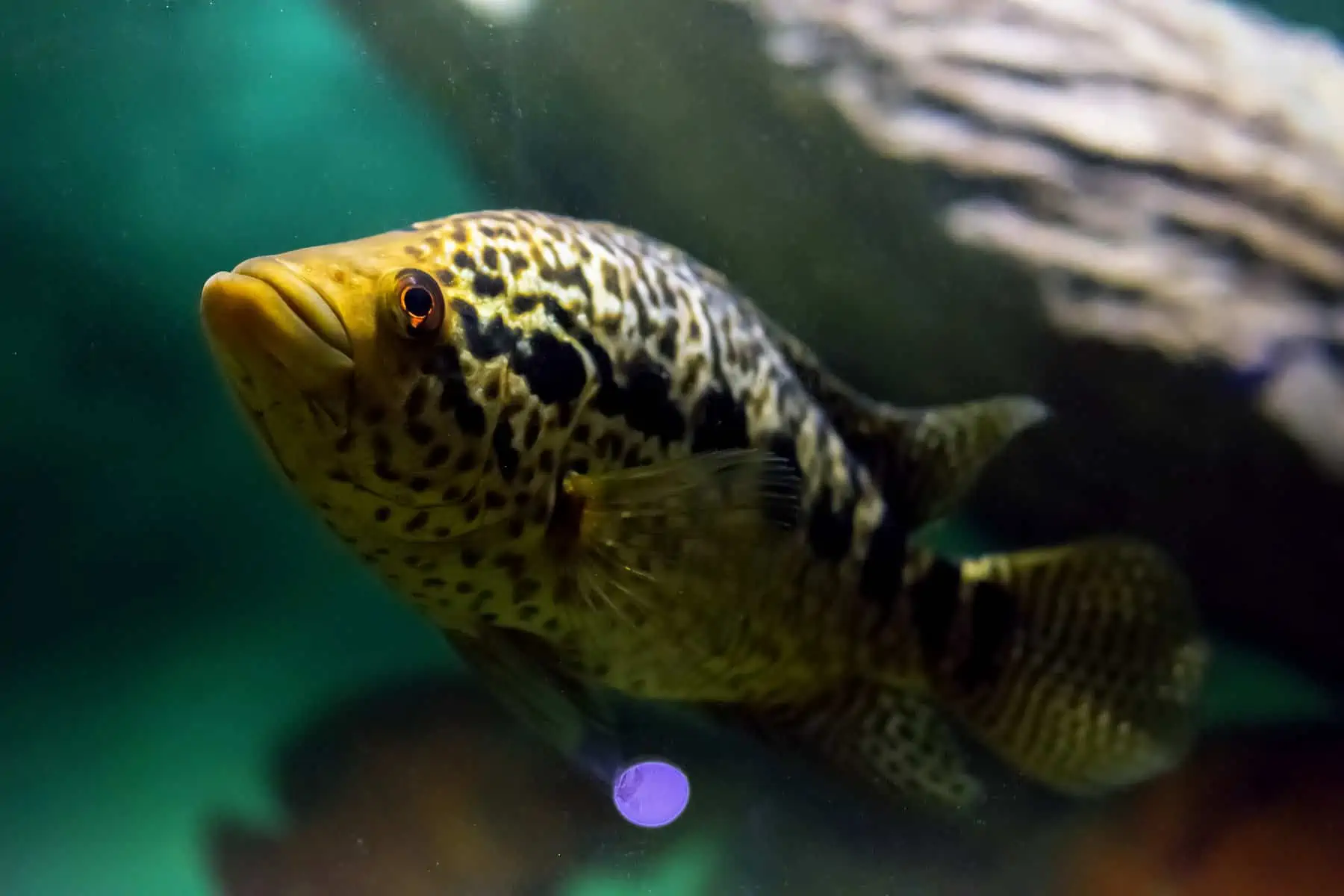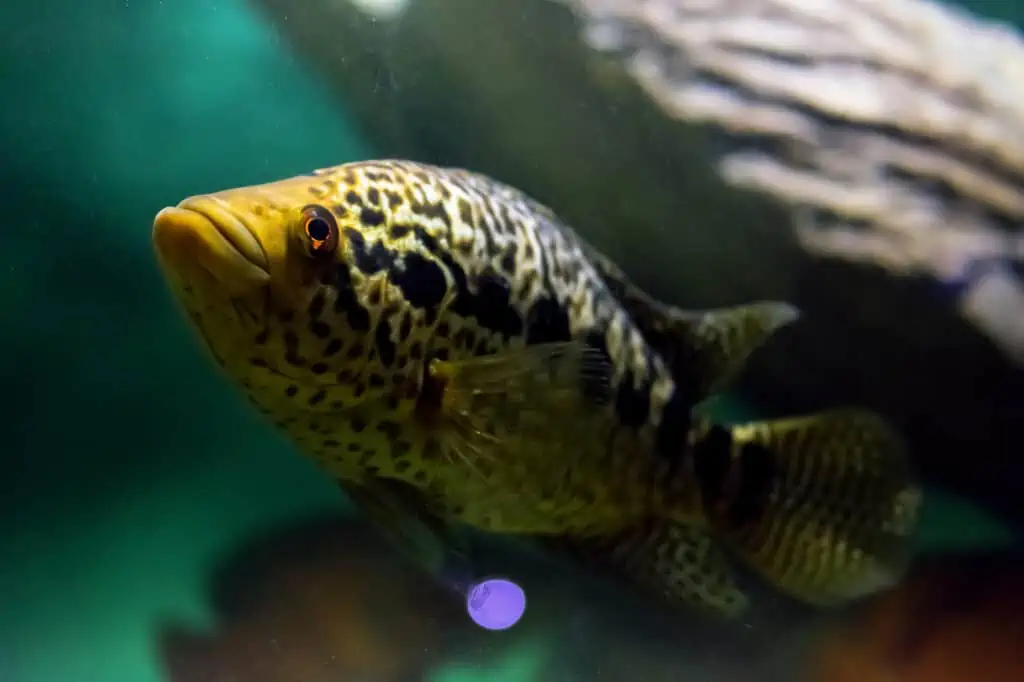If you’re looking for an impressive fish and you have a large tank, the Jaguar cichlid might be one you want to consider.
These are large, aggressive, predatory fish that can’t be kept in a community tank with smaller species that might be viewed as a food source. However, you can keep them in pairs and with other large, semi-aggressive cichlids to create a striking display.
Jaguar cichlids are relatively straightforward to care for, but we don’t recommend them for beginners because of their feisty nature. However, if you’re an experienced hobbyist, you might want to give these beautiful fish a try.
Read this guide to learn everything you need to know about caring for and breeding the Jaguar cichlid.
Jaguar Cichlid – At a Glance
| Jaguar Cichlid Info | |
|---|---|
| Common Name (species) | Jaguar cichlid, Jaguar guapote, Tiger guapote, Guapote tigre, Spotted guapote, Managua cichlid, Managuense cichlid, Aztec cichlid |
| Scientific name | Cichlasoma managuense |
| Family | Cichlidae |
| Origin | Central America |
| Diet | Carnivore |
| Care Level | Intermediate |
| Activity | Moderately active |
| Temperament | Aggressive, predatory |
| Tank Level | Mid to lower area of the water column |
| Minimum Tank Size | 125 gallons |
| Temperature Range | 75.0 to 82.0° F (23.9 to 27.8° C) |
| Water Hardness | 10 to 15 dGH |
| pH Range | 7.0 to 8.7 |
| Filtration/Flow Rate | Slow to medium flow rate |
| Breeding | Challenging due to aggressive temperament |
| Compatibility | Unsuitable for a community tank but can live with large semi-aggressive cichlids |
| OK for Planted Tanks? | Might dig up plants |
Background and Origins
Jaguar cichlids come from various locations across the Atlantic slope of Central America, primarily across Honduras and Nicaragua, and populations have also been introduced in Guatemala, Panama. and El Salvador. Jaguar cichlids can also be found in Florida, where they are regarded as an invasive species.
In their native lands, Jaguar cichlids are sometimes caught for human consumption. These highly predatory fish feed on large and small invertebrates in the wild environment.
Natural Habitat
The Jaguar cichlid lives in water bodies on the Atlantic slope of Central America, typically ranging from habitats in the Ulua River in Honduras to the Matina River in Costa Rica.
In their natural environment, these freshwater fish live in tropical waters, such as ponds, springs, and lakes, where the oxygen levels are typically low, and the substrate is muddy and littered with rocks and tree roots. However, in non-native habitats, Jaguar cichlids can be found living in ponds, canals, and other freshwater bodies.
Appearance
As juveniles, Jaguar cichlids have vertical bars on their bodies that resemble a tiger’s stripes. However, these bars are lost as the fish mature and are slowly replaced with a spotted jaguar pattern, which gives the fish its common name. This change in appearance always occurs in male fish, while some females never lose their stripes or lose them and never develop a pattern.
Like all cichlids, Jaguar cichlids have a well-developed set of pharyngeal teeth in their throat beside their regular teeth, making them perfectly adapted for a predatory lifestyle.
The fish have the typical elongated, compressed body shape of other members of the cichlid family. The body has a base color of yellowish-tan to golden and is covered with a series of large, irregular black blotches, resembling a jaguar’s rosettes, hence the fish’s common name. The spots are sometimes lighter around the edges, giving a more pronounced appearance.
The Jaguar cichlid’s fins are usually vibrantly colored, and the dorsal fin has a mixture of green and blue shades, and in contrast with the black spots on the fish’s body, the tail fin often has bright red coloration.
Just behind the gill cover is a distinctive black spot that resembles an eye and possibly acts as a predator deterrent.
Gender Determination
Male Jaguar cichlids are usually larger and have a more elongated shape than females. Males also tend to develop a more pronounced hump on their foreheads as they mature, and they typically have more pointed, longer dorsal and anal fins when compared to females.
Although it’s not always the case, male Jaguar cichlids sometimes have brighter and more intense colors than females, and their black spots are more defined.
Size
Jaguar cichlids are very large fish, often growing to measure between 14 and 16 inches long.
Lifespan
If you take on a Jaguar cichlid, you must be prepared for a long-term commitment since these fish have a lifespan of around 15 years when given the optimum care.
Activity Level
Jaguar cichlids are moderately active fish that spend their time cruising around the tank, looking for food and exploring their environment. However, it’s worth knowing that these are powerful fish that can jump, and that’s something to be aware of when you’re carrying out routine maintenance tasks on your aquarium.
Temperament
Jaguar cichlids are very territorial and can be rather aggressive toward other fish, especially during the breeding season or when defending their adopted territory.
In addition, these fish are highly predatory and often become aggressive toward larger tank mates. For that reason, these large, feisty fish are not recommended for community tanks unless you keep them with other large semi-aggressive species.
It’s essential that you provide plenty of swimming space for Jaguar cichlids, as these are very large fish, and you must also include lots of hiding places to help reduce stress and alleviate tension and aggression between tankmates.
Compatibility and Tankmates

As mentioned above, Jaguar cichlids do not make good tank mates for smaller fish species that could be viewed as prey. For the same reason, I don’t recommend keeping shrimp and freshwater crabs with this aggressive, predatory fish species.
However, a few suitable tank mates might include other large cichlids, such as:
- Green Terrors (Andinoacara rivulatus)
- Texas cichlids (Herichthys cyanoguttatus)
- Convict cichlids (Amatitlania spp.)
Other robust predatory species like large Oscars or Pike cichlids can get along with Jaguar cichlids, although you should watch them closely for signs of aggression and be prepared to separate the fish if necessary.
A few large armored catfish species, such as Synodontis catfish and Plecos, can also be considered because they are typically peaceful species that can tolerate the aggressive behavior of Jaguar cichlids.
Whatever fish species you choose as tankmates for your Jaguar cichlids, always ensure that those fish are not so small that they might be regarded as a food source.
Diet and Nutrition
In the wild, Jaguar cichlids eat small fish and large invertebrates, so you need to try to replicate that diet in your tank.
You can feed Jaguar cichlids on frozen and fresh foods, such as small feeder fish, tadpoles, earthworms, crickets, and cut-up chunks of larger fish and crayfish. Dry and freeze-dried foods are also sometimes acceptable.
You can also feed your fish warm-blooded animal meats, such as beef heart, chicken, or turkey. However, these foods should be fed only once in a while and must not be made part of the Jaguar cichlid’s regular diet since they contain high levels of fat, which can lead to various illnesses and problems in your fish
As with most fish, this species benefits from the addition of vitamins and supplements to their diet since no captive diet can completely replicate what the fish would eat in the wild.
Frequency of Feeding
I recommend feeding your cichlids once per day, ideally at the same time each day, so you don’t forget if you fed your fish or not.
It’s also best to allow one fasting day per week, as that can benefit the fish’s digestive system by preventing overfeeding and constipation.
Care Guide
In this part of our guide, we explain how to care for these large, impressive fish.
Tank Size
A single Jaguar cichlid needs a tank of at least 125 gallons. If you want to keep a breeding pair of these fish, you’ll need a tank of 180 gallons as a minimum. Keeping these fish in a spacious aquarium with ample hiding places should prevent them from becoming overly aggressive.
Tank Shape
I recommend a rectangular, long tank for Jaguar cichlids, as that provides plenty of swimming space and allows you to use decorations as territory markers, helping to keep aggression to a minimum.
As mentioned earlier, these fish can jump, so you’ll need an aquarium with a tightly fitting lid or at least a cover slide to prevent escapes.
Water Chemistry
Jaguar cichlids are tropical fish that can tolerate a wide variety of conditions. A water temperature of between 75.0 to 82.0° F is ideal, with a pH level in the range of 7.0 to 8.7 and water hardness of between 10 to 15 dGH.
Lighting
In their wild environment, Jaguar cichlids live in relatively cloudy water with lots of plant debris drifting through it, so for that reason, I recommend subdued lighting and dappled shade for these fish.
If you don’t want to change your regular lighting unit, you can achieve a dimly lit environment by using floating plants.
Decoration
Jaguar cichlids are a pain in a planted tank because they are notorious diggers and will uproot all your plants. However, if you like to have a green aquascape, that can be achieved by using potted aquatic plants and floating varieties, as mentioned earlier.
I find that heavy pieces of driftwood and smooth rocks work very well with Jaguar cichlids because these items of decoration are too heavy for the fish to move around easily and can also provide them with shelter and territorial markers.
Filtration
Like all large carnivores, Jaguar cichlids create a lot of waste that will quickly pollute your tank if you don’t have an efficient filtration system in place to deal with it.
However, since the waters where these fish live in the wild environment are relatively slow-moving, you need a system that generates a moderate to slow flow. Ideally, you want a canister filter system with an extra powerhead that gives you a GPH flow rate of at least four times per hour.
Habitat Maintenance
As with all fish tanks, you’ll need to spend time maintaining your tank and filter system every week by carrying out partial water changes, vacuuming the aquarium gravel, and keeping your plants tidy.
The filtration system will require cleaning every couple of weeks to prevent the media from becoming clogged, and you will need to replace the filter media every month or so, in line with the manufacturer’s recommendations.
Are Jaguar Cichlids Healthy Fish?

Jaguar cichlids are relatively hardy fish, although they can be susceptible to some common fish diseases, including Ich (White Spot disease), Fin Rot, Velvet disease, and swim bladder disorders.
However, the most common condition that can affect Jaguar cichlids is Hole-in-the-Head Disease or Head and Lateral Line Erosion (HLLE), which is characterized by the appearance of holes or pits along the fish’s lateral line and on its head.
The cause of HLLE is not clearly understood; however, stress, poor water quality, and nutritional deficiencies are contributory factors.
As with all fish diseases, prevention is much better than cure. You can do much to keep disease away by maintaining your aquarium properly and providing your fish with clean water, proper filtration, and a high-quality, balanced diet.
Breeding
Jaguar cichlids have been bred successfully in captivity for many years and make excellent parents.
As previously mentioned, Jaguar cichlids are highly aggressive even when breeding. Do not attempt to introduce a mature male to a mature female fish in the hope that they will simply get together and breed! That approach will probably result in fighting and aggression, particularly on the part of the male.
The best approach is to raise a group of juveniles together, hoping the fish pair off naturally. However, even established pairs of Jaguar cichlids should be housed in a tank of at least 180 gallons to prevent any aggressive behavior on the male’s part.
Preparation
If you want to initiate spawning in an established pair of mature Jaguar cichlids, keep them well fed, carry out 50% water changes twice weekly, and increase the water temperature slightly to 82° F.
Ensure that any other fish species housed in the aquarium are removed before this process, as they will probably eat the eggs and fry, which will definitely elicit an aggressive response from the parents, potentially leading to injuries and stress.
Spawning
When spawning begins, the male Jaguar cichlid displays to the female and becomes caring and protective of her. The female will be taking care of the eggs, so it is mostly down to the male to defend his family and ward off potential predators.
The fish will look for a well-covered, sheltered area, usually behind a large rock or stone, where the fry can safely hatch. The parents then dig out a shallow depression in the substrate to create a nest or egg pit.
The female fish lays her eggs nearby and fans them to remove dirt and debris, and both parents guard the eggs and nest against intruders. Once hatching time approaches, the female moves the eggs into the nest, where the fry can hatch in relative safety.
Raising the Fry
The fry typically hatches within 72 hours at a raised temperature of 82° F, and keeping the temperature high will help to prevent fungus from forming on the eggs. Once the fry hatch, we recommend carrying out 20% water changes every other day to keep the environment clean and healthy for the developing babies.
For the first three or four days, the fry feed on their egg sacs. After that, you can offer them Liquifry and baby powder fry food that you’ll get in your local fish store.
Around this time, you should transfer the fry to a nursery tank, where they can grow.
Availability
Jaguar cichlids are readily available from most good fish stores, and you can also buy them online.
Prices start at around $10 for a juvenile fish, so it’s a good idea to buy a pair of youngsters if you plan on breeding the fish once they mature.
Final Thoughts
I hope you enjoyed our guide to keeping Jaguar cichlids. If you do, please take a moment to hit the share button before you go!
Jaguar cichlids are large tropical freshwater fish that can make a colorful addition to a big tank. However, these predatory, aggressive fish do not make a good addition to a community tank containing small, peaceful species and invertebrates. That said, you can keep these feisty fish with other large semi-aggressive cichlid species that will not be regarded as a potential food source.
Did you successfully breed Jaguar cichlids in your home aquarium? Why not tell us about your fish in the comments box below?


